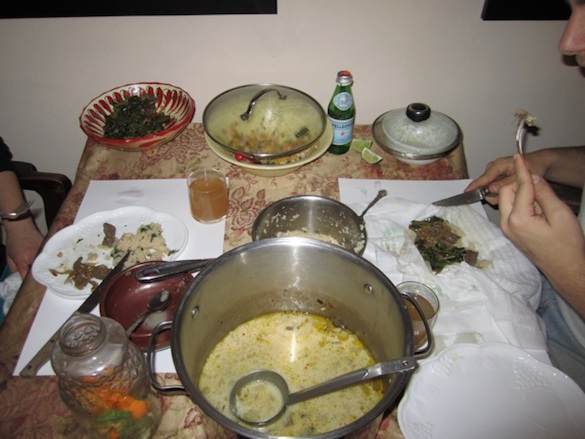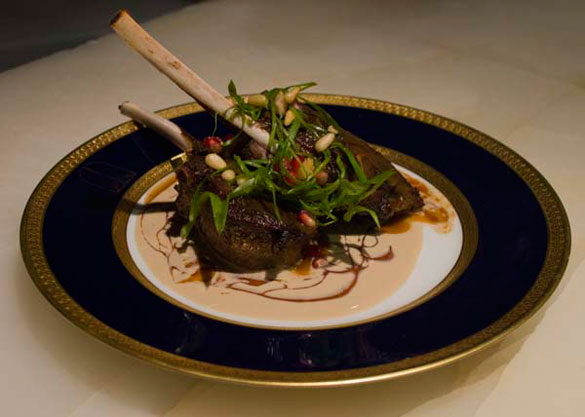December 2011 Archives

Before last week, I had never handled a Bitter Melon.
If you have never encountered one, Bitter Melons are warty, oblong gourd relatives with green, spongy fruit. Most abundantly grown and consumed in tropical areas of Asia, East Africa, and Latin America, Bitter Melons are used for both culinary and medicinal purposes around the world. In the US, bitter melons occupy an "ethnic food" cache, and remain to many an obscure and unappealing vegetable. When I paid for three bitter melons at a grocery store in Chicago's Chinatown last week, I was met by grins from behind the register.
The National Bitter Melon Council, an artist-collective-run organization started in Boston in 2004, capitalizes on these attributes. In their projects, the Bitter Melon becomes prop and propagator for orchestrating food-based interventions and performances. NBMC uses the vegetable to talk about bitterness socially, and broadly. Through collaboration with farm cooperatives, art spaces, and food education initiatives, as well as online and product-based franchising, they promote discussion about that which is unpleasant or rarely acknowledged. As they write in their mission statement: "Advocating the appreciation of this vegetable across cultures and cuisines, the NBMC believes that these Bitter Melon focused-events can bring whole communities together through a single shared experience -- that of bitterness."
In preparation for the National Bitter Melon Council installation for Feast, Andi Sutton, artist and NBMC director of public relations, sent me the following instructions:
Set the table for a dinner for two using the NBMC Place Mat and Napkin.
Prepare a series of dishes using Bitter Melon that make use of every object in the place setting.
Invite someone you don't know very well to eat with you. Eat and talk together.
The installation for Feast will feature NBMC-branded napkins and placemats, including a set used in the dinner that I made last week. As an art student and museum intern, I am used to receiving unconventional requests. But there is something unusually awkward about being asked to express bitterness. In addition to advocating knowledge about an "under-appreciated" vegetable, NBMC seeks to challenge the difficulty of addressing bitterness within the same venues in which we are used to experiencing pleasure -- eating may be the starting place, but the parameters of their mission are not limited to eating experiences. My participation in this meal involved me in a number of ways simultaneously. Though the recipes and impetus for the meal were not my own, as cook and host, I felt responsible for my guest.
Having decided to prepare the Bitter Melons in a few different ways, and uncertain of the results, I became invested in the cooking process. Serving my guest, Michael Bridges, I was surprised by my feelings of apprehension. Was I feeling bitter? Do feelings of bitterness always figure into the roles of hosting and receiving, or of participating in someone else's project?
Meal-based art practices often destabilize or highlight the sensational and social aspects of eating, and over the course of this meal, and my conversation with Michael, my feelings of apprehension were subsumed by a sense of joint enterprise. Both aware that we were performing for each other, the dinner became a meditation on the nature of participation. Through our use, both guided by Andi's instructions and independent of them, the Bitter Melon dishes and NBMC-branded tableware became objects of enjoyment, disgust, abjection, humor, and absurdity.
Recipes prepared for a Bitter Melon dinner on December 5, 2011:
- Bitter Melon Soup with Mango and Shrimp Salsa
- Bitter Melon Beef
- Bitter Melon Cous Cous
- Bitter Melon-Infused Tequila with Ginger Ale and Lime
- Macerated Bitter Melon Sauce with Sorbet and Cookies
Rachel Maddow on the end of Michael Rakowitz's Spoils project and the return of Saddam Hussein's china to Iraq. For Feast, Rakowitz will launch a food truck in Chicago serving Iraqi cuisine on paper replicas of the chinaware.

Today is a historic day in US-Iraqi relations: President Obama gave a speech earlier this afternoon to mark the official end of US military presence in Iraq. It feels right, then, to pause for a moment of reflection. Let's think, today, about the weight and impact of nearly nine years of non-war. Let's reflect on the complexities of this conflict and its profound impact on the world, on our two nations, and on so many individual people.
The artist Michael Rakowitz is a wonderful companion for such reflections. Since 2003, he has thoughtfully addressed this cross-cultural conflict through a body of work in which he uses his heritage as an American of Iraqi-Jewish descent as one point of departure for new art. In a lot of this work, Rakowitz spins fabulous-but-true stories around historic objects, historical events, and unlikely coincidences. In The Invisible Enemy Should Not Exist, for instance, he is creating replicas of ancient artifacts that are missing, looted, or stolen from the Iraq National Museum.
And for Feast, Michael is extending his ongoing Enemy Kitchen project. That project, which we've covered in prior posts, will take its most ambitious form yet -- a food truck. Through a collaboration between the artist, Iraqi chefs, and members of Iraq Veterans Against the War, the truck will serve up Iraqi food to the public -- presenting it on paper plates printed to match some of Saddam Hussein's china.
That actual china is now on its way back to Iraq, reversing the path taken by those final homeward-bound soldiers. It's a wild coincidence of timing. Just yesterday, Michael was required to hand this china -- which had been purchased on eBay -- over to representatives of the Iraqi government so that it can travel back to Iraq with Prime Minister Nouri al-Maliki. (The dishes came to the Iraqi government's attention in late November because Michael was using them in an Enemy Kitchen-related project sponsored by the public art organization Creative Time.)
Today seems an especially appropriate day to think about these intersecting trajectories of soldiers, china, cultural traditions -- and to consider that time-honored question of what's at stake as artists navigate the intersections of politics and aesthetics.
Top: Michael Rakowitz, Spoils, dish detail, 2011, photograph by Christopher Kissock, Courtesy of Creative Time.